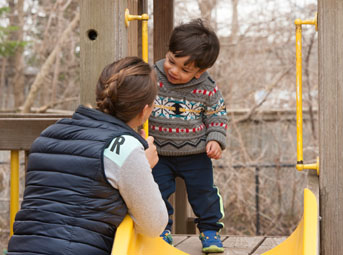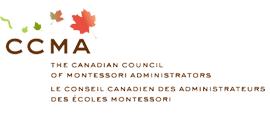Practical Life Activities
One of the most important areas in our classroom isn’t the advanced math area, but the practical life area. This is the place where our young arrivals start. In practical life we lay a solid foundation on which the child can grow. The fact that your child learns to sweep the floor may not impress you much, but we know the value!
Your child will work with everyday objects that have a visible purpose. A three year old will learn to carefully pour a drink and then clean up afterwards. He knows that he’s done important work because he’s seen you do the same thing at home. This part of our classroom offers your child a comfortable link between home and school, and it allows him to practice being just like an adult. While moving through this part of the curriculum, your child will learn to pay attention to detail, to persevere, to gain precision, and to develop great concentration. His fine motor skills will improve dramatically, his ability to focus on his work will grow even longer, and his organizational skills will begin to develop.
Look at the pictures of students on our site and you'll notice intense concentration on their faces. They are focused and happy in their important work. Now imagine these children in two years. They will be equally focused and happy while doing four-digit subtraction with borrowing. Why? Because they learned how to learn and concentrate when they were three years of age.
Sensorial Activities
This area of our classroom is filled with materials that help refine your child’s senses.
There are items that vary in colour, shape, texture, or sound. This will encourage your child to notice small, but important, differences. Here, the children start to distinguish, and to categorize.
Sensorial activities provide opportunities to learn about the colours and shapes that surround us. It’s a stepping off point for so many interesting activities! The sensorial area also has early math and early writing activities.
Language & Reading
Language and reading is a process that develops step by step.
Your child will learn to identify sounds through the use of the ‘sandpaper letters’. This learning material is a typical example of Maria Montessori’s genius. The letters can be ‘seen’ and ‘felt’, and the teacher makes the ‘sound’ of the letter. This allows the child to learn easily, regardless of whether his preferred learning style is visual, tactile, or auditory. Once the sounds (phonics) are mastered, he can then string them together to form words. He’ll learn that ‘t’ is the sound at the beginning of ‘ten’. He’ll learn that ‘h’ is the sound at the beginning of ‘hat’. Once this skill is mastered, he’ll learn that when you put ‘t’ and ‘h’ together you get the ‘th’ sound.
Step by step, he’ll move through the phonograms to a place where reading is a pleasure and writing is easy. In the meantime, his confidence is growing and his brain is developing at a rapid pace. Learning at this stage of life can be effortless.
Mathematics
Many children have difficulty building the fundamentals of math because the concepts are so abstract. In Montessori we introduce these concepts using concrete, physical materials in order for the students to build a real understanding of what the numbers mean. For example: using the bead material a child holds one solitary bead (one unit) and associates it with the abstract concept of the number ‘one’. From here they move onto ten units make a ‘ten’, ten ‘tens’ make a ‘hundred’, ten ‘hundreds’ make a ‘thousand’, and so forth. Eventually, in the elementary program, a student gets introduced to the million cube. This leaves our young students with a firm grasp of what a million actually is, a number that often remains abstract even in the minds of adults.
When a Montessori trained child hears the number 10,623, he visualizes 10 thousand cubes, 6 hundred squares, 2 tens, and 3 units. It makes sense to him. That’s why Montessori children can work so effectively in math. They don’t just learn by rote. They actually understand what they are doing.
It’s important to point out the difference between rote learning and the Montessori approach.
Rote learning teaches a child the answer. They memorize that five multiplied by five equals twenty-five. They don’t necessarily understand the ‘why’ or the ‘how’. When given a new question to work out, a child who has learned by memorization probably won’t have the tools to come up with the correct answer, but a Montessori child does. He can extrapolate. He can find the answer. It makes sense to him.
As the children work with the various addition materials, they learn time and again that when you put 8 beads together with 6 beads you will always arrive at a total of 14 beads. It doesn’t matter whether you use the individual beads, the bead stairs, the addition strip boards, or the stamp game. The answer is always the same.
Eventually, it just becomes something they ‘know’. There is less of a requirement for tedious memorization. It just becomes part of the child’s knowledge. How wonderful is that!
Art & Culture
Learning math and language is so very important in today’s fast paced and competitive world. The beauty of a Montessori approach is that, not only does your child have the opportunity to make incredible progress academically, but she also has the chance to develop through art and a better understanding of culture.
Your child will learn about the natural world around her, about animals and plants, land forms and other countries.
Why don’t polar bears live in Africa? Which countries are on the equator? Where is North America?
In learning about the world, your child begins to understand where she fits in. Her sense of what is important in life will begin to develop. She will start to gain compassion and a deeper understanding of the world around her. We have so much to be thankful for and so much to appreciate.
Your child gets the opportunity to be creative and use their imagination. We encourage them to draw, colour, do crafts, and paint.




